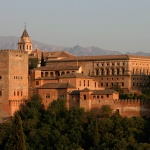Sights Granada, Spain
 Among its many cultural resources allocated magnificent palaces The Alhambra and the Generalife, the Arab quarter Albasin, Cathedral and Royal Chapel where the remains of Queen Isabella and King Fernando of Aragon, Science Park and, finally, all those city streets, walking along which you can learn about the history of Granada .
Among its many cultural resources allocated magnificent palaces The Alhambra and the Generalife, the Arab quarter Albasin, Cathedral and Royal Chapel where the remains of Queen Isabella and King Fernando of Aragon, Science Park and, finally, all those city streets, walking along which you can learn about the history of Granada .In the city there are many cultural events, including festivals, music and dance, tango, jazz, cinema, theater and, of course, grandiose performances of flamenco in the caves of Sacromonte. There are at Granada Studios and wonderful musical instruments - guitars, castanets, etc.
The most ancient part of Granada - Albaysin. This is a suburb of Granada, beautifully situated on a hill at the foot of which flows the river Darra, sung in Spanish poetry from famous poets of the Middle Ages and ending with Federico Garcia Lorca. Name of area translates as "the owners of Falcon. From Granada Albaysin linked steep hill, leading directly to the cathedral. From the terrace of the Church of St. Nicholas, a beautiful view of the Alhambra and part of Granada, located in the valley.
After the capitulation of Granada population Albaysina were Moriscos (Moors converts to Christianity), until their rebellion in 1568, after which the majority of Moriscos were destroyed or resettled in other centers. Nevertheless, the lifestyle of this part of Granada's Moorish roots retained. Before construction of the Alhambra here was the residence of the rulers of Granada. Preserved remains of the walls of the IX. Who defended the city.
Later Albaysin became the center of arts and crafts. Granada master famous for manufacturing of brocade and silk, jewelry, precious stones, precious weapon. And to this day Albaysina streets are filled with a variety of workshops. After the expulsion of the Moriscos of Granada Albaysina and the adjacent hill Sacromonte were settled gypsies, who lived in caves dug in the hillside. Currently, the majority of the remaining caves are used as garages, warehouses, utility rooms. In some caves house the museum gypsy way of life, as well as exotic taverns, where every night give an idea of flamenco.
Albaysin resembles an independent city with many churches and houses, climbing up the hill and surrounded by gardens (this type of house with a garden here is called "Carmen"
.
Many modern Christian churches Albaysina - the former mosque. Usually the mosque itself was destroyed, and the minaret was preserved and served as a belfry. Such, for example, the Church of San Jose with a minaret in the XI., The Gothic church of San Juan de los Reyes, built on the site of a mosque with a minaret Ataybin XIII century. In Albaysine can meet a lot of Moorish dwellings and baths in the XI. the oldest in Spain, with vaulted domes and capitals are not only the Gothic, and Arab, but even more ancient Roman work.
Nearby is the palace Casa del Castrillo with elegant portal in 1539 architect Sebastian de Alcantara. The palace is now the Archaeological Museum. Presented here not only archaeological materials, but also the paintings of artists of Granada School. The central part of Granada is situated at the foot of the hill Albaysin. In the vicinity of each other here are the cathedral, shopping district Alkayseriya, Ayuntamento, an ancient area Bibrambla and several other monuments. Alkayseriya - the former indoor market, which suffered greatly in the middle of the XIX century. and was almost completely renovated. Adjacent to Alkayseriey, in the palace of La Madras (the former madrasah), located Ayuntamento (city council). It was in this building after the liberation of Granada, Isabella and Ferdinand collected the first city council. In the subsequent era facade of the building was substantially rebuilt, having lost their original appearance.
Near La Madras is located Corral del Carbon (Coal Yard) - one of the most interesting buildings in the city. In Arab times, there were market and hotel. This is the only preserved in Europe, Arabic inn. Memorial of the liberation of Granada and the central building of the city became the Cathedral, whose construction was started in 1523 Albaysin down to Darra, where the river flows in a deep ravine. On the other side of the ravine, thickly overgrown with elm, beech and oak trees, climbs the high hill of Al-Sabika, on which stands the Alhambra. From the elevated points Albaysina offering a panoramic view of the famous architectural complex with its thick walls and the rhythm of the numerous towers.
In Granada, there are many buildings, rich in artistic values. Among them, first and foremost it should be noted kartuziantsev La Kartuha Monastery (La Cartuja), beautifully situated in the northern part of the city. This reconstructed Gothic building, which lead from the cathedral street Gran Via de Colon and Kartuha. The monastery is known stored in its numerous works of art, an abundance of different types of marble, serpentine, jasper, onyx, agates, etc. Such wealth is rare in the churches of Spain. Some types of marble are imbued with veins and are covered with fantastic patterns, resembling a human shape, then animals, and sometimes subtle contours of the leaves. One might think that this skillfully made a mosaic - a creation of human hands.